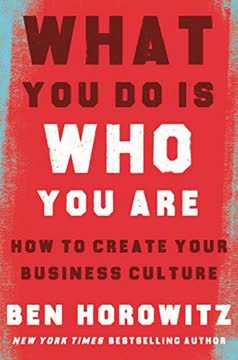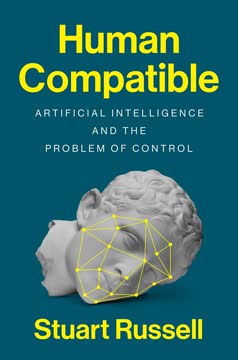Key Takeaways
1. The Alliance: A New Framework for Employer-Employee Relationships
The Alliance lays out a path forward for companies and their employees.
Trust through honesty. The alliance framework redefines the employer-employee relationship for the modern era. It acknowledges that lifetime employment is no longer feasible, but recognizes the need for mutual trust and investment.
Mutual benefit. Under the alliance, both parties commit to adding value to each other. The company invests in the employee's long-term market value, while the employee contributes to the company's adaptability and success. This creates a win-win scenario where both can thrive.
Team, not family. The alliance reframes the company as a team rather than a family. This allows for a more realistic and productive relationship, where members work together towards specific goals while maintaining individual aspirations.
2. Tours of Duty: Organizing Work Around Finite Missions
A tour of duty represents an ethical commitment by employer and employee to a specific mission.
Three types of tours:
- Rotational: Fixed-term, standardized roles for entry-level or interchangeable positions
- Transformational: Personalized, mission-based assignments to drive mutual growth
- Foundational: Long-term commitments for key employees integral to the company's future
Defined missions and timelines. Tours of duty provide clear objectives and time frames, typically lasting 2-5 years. This clarity allows both parties to invest in the relationship while maintaining flexibility.
Career development. Tours of duty are designed to enhance an employee's skills and marketability, even if they eventually leave the company. This approach attracts top talent and encourages high performance during the tour.
3. Building Alignment: Aligning Employee and Company Goals
Alignment means that managers should explicitly seek and highlight the commonality between the company's purpose and values and the employee's career purpose and values.
Shared objectives. The alliance framework emphasizes finding common ground between the company's mission and the employee's career aspirations. This alignment creates a stronger, more productive relationship.
Open communication. Managers should have honest conversations with employees about their goals, values, and desired career trajectories. This transparency builds trust and helps define mutually beneficial tours of duty.
Flexibility in alignment. Perfect congruence isn't necessary; the goal is to find sufficient overlap for the duration of a specific tour of duty. This allows for changing aspirations and company needs over time.
4. Implementing Transformational Tours: Steps for Successful Execution
The tour of duty you define with your employee should have a clear, detailed, concrete mission objective.
Four key steps:
- Define the mission and expected outcomes for both company and employee
- Set up regular checkpoints for feedback and progress assessment
- Begin discussing the next tour before the current one ends
- Manage unexpected changes collaboratively
Mutual accountability. Both employer and employee are responsible for the tour's success. Regular check-ins ensure alignment and allow for course corrections if needed.
Transition planning. Whether an employee moves to a new tour within the company or leaves for an external opportunity, proper succession and transition planning is crucial for maintaining the alliance.
5. Network Intelligence: Leveraging Employee Networks for Company Benefit
Think of each employee as an individual scout picking up data from the outside world—from articles, books, and classes, but most important, from other friends inside and outside the industry.
Valuable intelligence. Employee networks provide access to industry trends, competitive information, and potential opportunities that may not be publicly available.
Implementation strategies:
- Recruit well-connected individuals
- Teach employees how to ethically gather and share intelligence
- Provide resources for network building (e.g., networking funds, speaking opportunities)
- Create systems for sharing gathered information within the company
Mutual benefit. Encouraging network intelligence helps employees grow their professional networks while providing valuable insights to the company.
6. Corporate Alumni Networks: Maintaining Lifelong Relationships
Lifetime employment might be over, but a lifetime relationship remains the ideal.
Benefits of alumni networks:
- Hiring: Source of boomerang employees and referrals
- Intelligence: Insights on industry trends and company perception
- Business development: Customer referrals and brand ambassadorship
Investment levels:
- Ignore: Missing out on potential benefits
- Support: Informal assistance to alumni-led groups
- Invest: Formal infrastructure and systematic benefits
Reciprocal relationship. Successful alumni networks offer real value to former employees in exchange for their continued engagement and support.
7. Adapting to the Networked Age: Long-Term Thinking in a Changing World
A business without loyalty is a business without long-term thinking. A business without long-term thinking is a business that's unable to invest in the future.
Balancing flexibility and commitment. The alliance framework encourages companies to invest in their employees' long-term success while maintaining the adaptability needed in today's rapidly changing business environment.
Cultural shift. Adopting the alliance mindset requires a change in how companies and employees view their relationship. It emphasizes mutual benefit, trust, and ongoing investment in each other's success.
Societal impact. By improving workplace relationships and encouraging long-term thinking, the alliance framework has the potential to create positive change beyond individual companies, benefiting the broader economy and society.
Last updated:
FAQ
What's "The Alliance: Managing Talent in the Networked Age" about?
- Overview: "The Alliance" by Reid Hoffman, Ben Casnocha, and Chris Yeh explores a new framework for employer-employee relationships in the modern, networked age.
- Core Concept: The book introduces the idea of treating employment as an alliance, where both parties make mutual promises and investments.
- Purpose: It aims to replace the outdated models of lifetime employment and free agency with a more adaptable and honest approach.
- Focus: The book emphasizes building trust, mutual investment, and long-term relationships even after employment ends.
Why should I read "The Alliance: Managing Talent in the Networked Age"?
- Modern Relevance: It addresses the challenges of managing talent in today's rapidly changing business environment.
- Practical Framework: Offers actionable strategies for building stronger, more honest relationships between employers and employees.
- Insightful Examples: Provides real-world examples from companies like LinkedIn and PayPal to illustrate its concepts.
- Career Development: Helps both managers and employees understand how to align their goals for mutual benefit.
What are the key takeaways of "The Alliance: Managing Talent in the Networked Age"?
- Alliance Framework: Employment should be viewed as a mutually beneficial alliance rather than a transactional relationship.
- Tours of Duty: Introduces the concept of "tours of duty" to structure employment relationships with clear, finite missions.
- Network Intelligence: Encourages leveraging employee networks for competitive advantage and innovation.
- Corporate Alumni Networks: Highlights the importance of maintaining relationships with former employees for ongoing mutual benefit.
How does "The Alliance" redefine the employer-employee relationship?
- Mutual Investment: Both parties invest in each other's success, with the company enhancing the employee's market value and the employee contributing to the company's growth.
- Honest Conversations: Encourages open discussions about career goals and company needs to build trust and alignment.
- Adaptability: Emphasizes the need for flexibility in roles and responsibilities to adapt to changing business landscapes.
- Long-term Relationships: Advocates for maintaining connections with employees even after they leave the company.
What is the "Tours of Duty" concept in "The Alliance"?
- Defined Missions: A "tour of duty" is a specific, finite mission that an employee undertakes within a company.
- Mutual Benefits: It aligns the employee's career goals with the company's objectives, providing clear benefits for both.
- Types of Tours: The book describes different types of tours, including Rotational, Transformational, and Foundational, each with varying levels of commitment and alignment.
- Flexibility: Tours of duty allow for adaptability and growth, enabling employees to take on new challenges and roles.
How does "The Alliance" suggest implementing network intelligence?
- Leverage Employee Networks: Encourages employees to use their personal and professional networks to gather valuable information and insights.
- Encourage External Engagement: Supports activities like attending conferences and networking events to expand knowledge and connections.
- Structured Sharing: Establishes processes for employees to share what they learn with the company, enhancing collective intelligence.
- Cultural Shift: Promotes a culture where networking is seen as a valuable asset rather than a distraction.
What role do corporate alumni networks play in "The Alliance"?
- Lifelong Relationships: Alumni networks maintain connections with former employees, extending the alliance beyond active employment.
- Mutual Benefits: Alumni can provide referrals, insights, and even return to the company, benefiting both parties.
- Investment Levels: The book outlines different levels of investment in alumni networks, from basic support to comprehensive engagement.
- Brand Ambassadors: Alumni can enhance the company's brand and reputation through their ongoing success and advocacy.
How does "The Alliance" address the challenges of modern employment?
- Trust and Loyalty: Aims to rebuild trust and loyalty in an era where traditional employment models have broken down.
- Adaptability: Provides a framework for companies to remain adaptable and innovative in a fast-paced environment.
- Employee Engagement: Focuses on engaging employees by aligning their personal goals with the company's mission.
- Long-term Thinking: Encourages companies to invest in their employees' futures, fostering a culture of long-term growth and success.
What are some practical strategies from "The Alliance" for managers?
- Define Clear Missions: Use tours of duty to set clear, achievable goals for employees that align with company objectives.
- Foster Open Communication: Encourage honest conversations about career aspirations and company needs to build trust.
- Support Networking: Provide resources and opportunities for employees to expand their networks and bring back valuable insights.
- Maintain Alumni Connections: Develop and invest in corporate alumni networks to leverage former employees' expertise and influence.
What are the best quotes from "The Alliance" and what do they mean?
- "Help make our company more valuable, and we’ll make you more valuable." This quote encapsulates the mutual investment philosophy of the alliance framework.
- "We’re a team, not a family." Emphasizes the importance of treating employment as a professional relationship with clear goals and expectations.
- "A business without loyalty is a business without long-term thinking." Highlights the need for trust and loyalty to drive sustainable success.
- "The alliance makes employees more valuable by making them more adaptive and skillful." Underlines the focus on employee development and adaptability.
How can "The Alliance" help employees advance their careers?
- Career Transformation: Tours of duty provide structured opportunities for employees to gain new skills and experiences.
- Networking Opportunities: Encourages building and leveraging professional networks for career growth and development.
- Alignment with Goals: Helps employees align their personal aspirations with their roles, leading to more fulfilling work.
- Ongoing Relationships: Maintains connections with former employers through alumni networks, offering continued support and opportunities.
How does "The Alliance" apply to different industries and roles?
- Universal Principles: The alliance framework is adaptable to various industries and roles, focusing on mutual benefit and adaptability.
- Customizable Tours: Tours of duty can be tailored to fit the specific needs and goals of different sectors and job functions.
- Scalable Strategies: The book provides scalable strategies for companies of all sizes, from start-ups to large corporations.
- Industry Examples: Offers examples from diverse industries, including tech, consulting, and manufacturing, to illustrate its concepts.
Review Summary
The Alliance receives mixed reviews, with praise for its fresh perspective on modern employment relationships and practical strategies for managers. Readers appreciate the concept of "tours of duty" and the emphasis on mutual benefit between employers and employees. Some criticize the book's focus on LinkedIn and Silicon Valley examples, while others find it repetitive. Overall, reviewers consider it a quick, insightful read that offers valuable ideas for adapting to the changing nature of work in the 21st century.
Similar Books










Download PDF
Download EPUB
.epub digital book format is ideal for reading ebooks on phones, tablets, and e-readers.









